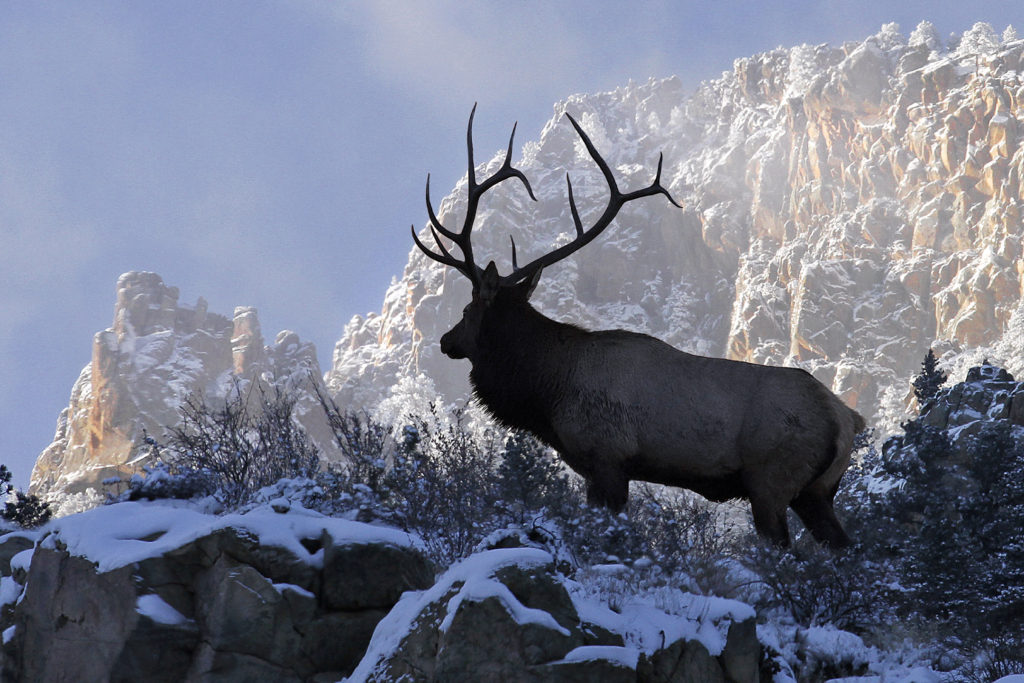Final year of reintroduction effort provides 60 Kentucky elk to Wisconsin’s Northwoods
Contact(s): Kevin Wallenfang, DNR big game ecologist, 608-261-7589

The Wisconsin DNR has released the final round of translocated elk in Sawyer County, bringing the state’s herd close to 300 animals.Photo credit: DNR
WINTER, Wis. – After the final and most successful winter trapping effort, 60 more elk joined Wisconsin’s growing herd. The elk are now settling into their new home in northern Wisconsin after their release from the acclimation and quarantine pen.
Forty-eight elk arrived at the holding pen this year in March, but numbers grew as pregnant cows gave birth this summer. The release of these 60 elk marks the fifth and final year of Wisconsin’s elk translocation efforts and the second release of elk into the northern elk range in Sawyer County. Thirty-one elk were released here in 2017.
“We’re happy to have the translocation effort complete and look forward to seeing the herd continue to grow,” said Kevin Wallenfang, the Wisconsin DNR big game ecologist and elk reintroduction coordinator. “There are always challenges when holding live, wild animals for extended periods, but overall it was a successful effort and we surpassed our project goals.”
“Both of Wisconsin’s elk herds are doing quite well and increasing in numbers,” Wallenfang said.
Wisconsin DNR worked with several key partners to release a total of 164 elk since 2015. Some were used to start a new wild elk herd in Jackson County in 2015, now estimated to be approximately at 80 elk. In addition, more Kentucky elk were added to the northern herd which was first established in 1995. That herd is now approaching 300 elk.
The Kentucky Department of Fish and Wildlife Resources, Rocky Mountain Elk Foundation, Ho-Chunk Nation, Great Lakes Indian Fish and Wildlife Commission, Jackson County Wildlife Fund, Flambeau River State Forest, U.S. Forest Service, Jackson County Forestry and Park, and several others provided funding and other support for the project.
Each year upon arrival from Kentucky, the elk received 24-hour care and monitoring while being held in a seven-acre pen during the required quarantine period. This year’s quarantine was extended into early August to conduct additional bovine tuberculosis testing for one “suspect” animal. Ultimately, that animal did not have the disease and the quarantine was lifted earlier this month.
Before release, each elk is fitted with a tracking collar that will provide years of extremely useful information about elk movements, habitat preference, survival information, and much more.
September Brings Great Opportunity to See and Hear Wisconsin Elk
Wisconsin’s two elk herds are being observed and enjoyed by many, and September is a particularly great time to make a trip to the elk ranges.
“The rut will soon be here, which means a great chance to catch a glimpse of elk and hear them bugling,” Wallenfang said. “Traveling the area at dawn and dusk will offer the best opportunity. The bulls will start bugling in late August and continue through September as they search out females and fend off other bulls.”
When viewing elk, remember to keep your distance to avoid unnecessary disturbance of the elk, especially those recently released into the Flambeau River State Forest that will be settling into the area for several weeks.
To receive email updates regarding current translocation efforts, visit dnr.wi.govand click on the email icon near the bottom of the page titled “subscribe for updates for DNR topics.” Then follow the prompts and select the “elk in Wisconsin” and “wildlife projects” distribution lists.
For more information regarding elk in Wisconsin, visit dnr.wi.gov and search keyword “elk.”
